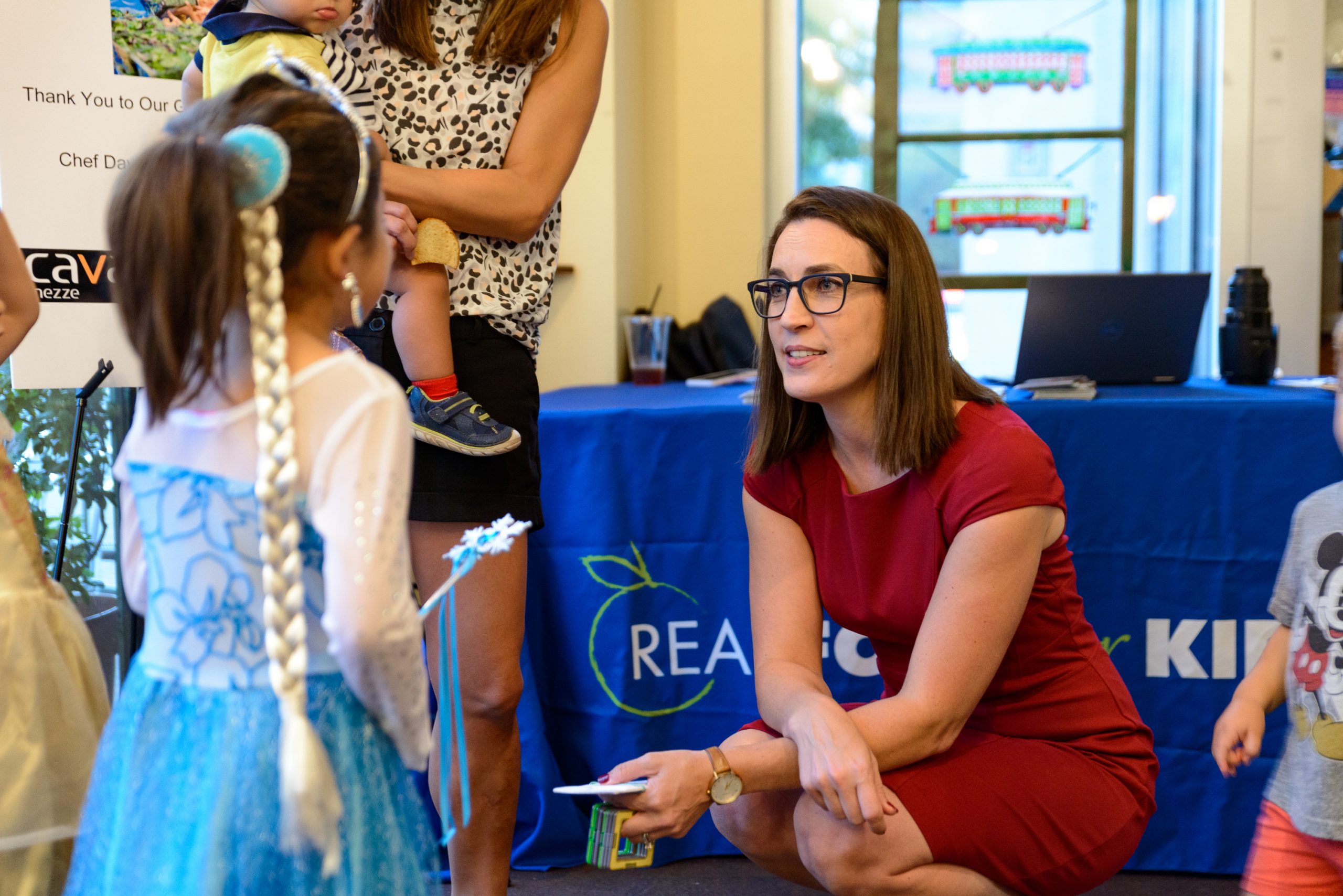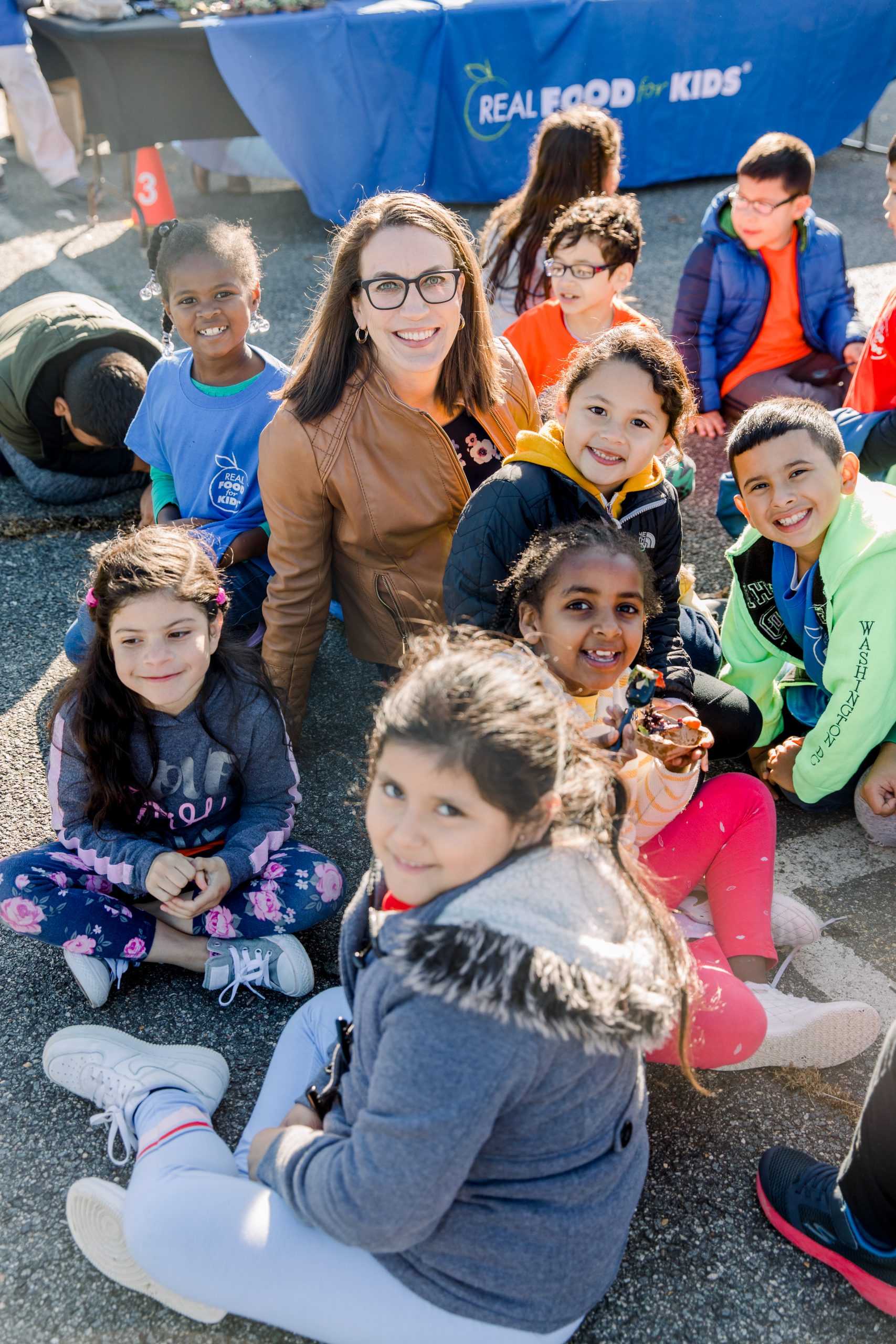Jenn Yates celebrates one year at Real Food for Kids
November 25, 2019 • 7 minute read

Photo Credit: Scott Spaulding
Long before she took on the role of fighting for healthy school food as Executive Director of Real Food for Kids in Arlington, Virginia, Jenn Yates experienced firsthand the issues of food insecurity and lack of access to healthy foods that she now works to address.
Infinite Global is proud to sponsor Real Food for Kids. We recently sat down with Jenn to learn more about her journey and the organization that she leads.
Q: Tell us a little bit about your background.
Growing up, social safety net programs (free school lunch, food stamps, etc.) were critical to providing me and my siblings with the fuel we needed to get through each day. But because these resources only stretched so far, we still lacked access to fresh fruits, vegetables and healthy meats. It wasn’t until my adult years that I began to realize the connection between the food I ate and the way it affected my wellbeing.
Throughout my childhood, I struggled with feeling hungry all the time, even when I had recently eaten. At school, I often felt shaky, unable to concentrate and desperate to get to my next snack or meal. Things changed once I began paying attention to the food I was putting in my body as an adult. I noticed that I stayed full longer and felt better when I ate foods that would take my body longer to break down and digest, like whole grains and vegetables. And this helped me perform better in all aspects of life.
My experience helped me to realize how important it is to teach kids healthy eating lessons early on before they develop bad habits and taste preferences that can last a lifetime. This is why school lunches are critical. They are an important opportunity to introduce concepts that will help kids to make better decisions about food as they grow, positively impacting the rest of their lives. School meals are really as integral to student success as any other part of the academic day.
Q: What first got you involved in the advocacy space? Specifically, around food and hunger.
After receiving a degree in political science and mass communications, I worked on congressional campaigns on the west coast. The campaign organizing experience became crucial to the trajectory of my career when I decided to pick up and move to Washington, DC, to follow my dream of applying these skills to advocating for environmental issues.
I was offered a position at the Union of Concerned Scientists [UCS], to help build public support for sustainable agriculture and healthy food policy. This was in 2002, at a time when sustainable agriculture was not as high profile as it is today (the organic label made its debut that year and farmers markets were still relatively scarce). I saw great potential to be at the forefront of a healthier food movement, both as an environmental and public health issue. I ended up spending 14 years at UCS and was really gratified to see the remarkable progress that was made in that time in building public awareness about the connection between our food system, the environment and our health.
Q: How did you get involved with Real Food for Kids?
During my time at UCS, I led our campaign to improve child nutrition programs. We looked at how to best leverage the billions of dollars we spend each year on these programs — most notably school lunch — to get the best possible outcomes for kids’ health, especially in light of the childhood obesity epidemic. In the course of this work, I learned of the many significant barriers that schools face when trying to provide high-quality food for kids. But I also learned about some remarkable school food leaders from around the country who were overcoming these barriers to not just meet minimum federal nutrition guidelines, but to use school lunch as an opportunity to teach kids healthy eating habits and offer freshly made, delicious foods that kids love and parents felt good about.
As my son was starting kindergarten, I realized I wasn’t yet familiar with my area’s school lunch programs, so I did what anyone would do and Googled it! That’s when I found Real Food for Kids, and I immediately reached out to ask how I could get involved. A few months later I was hired to lead the organization, and as they say, the rest is history!
Q: Tell us about your newest program.
This year we launched our newest program, Fresh Food Explorers, which provides nutritional education to students from disadvantaged communities. We visit low-income preschool classrooms over eight weeks and share different fruits and vegetables, getting kids familiar with these healthy foods in a fun and interactive environment. This program touches three key areas:
- It familiarizes children with healthy food options in a low-pressure setting. Among their peers, they can pass around and try different fruits and vegetables that they may not have experienced before.
- It primes children to be more accepting of vegetables offered in the lunchroom, reassuring budget-conscious school food directors that the kids will enjoy these menu items if they are offered and not just throw them away.
- It involves families. We invite parents and other family members to informational sessions where we tell them what their kids are learning, offer recipes and tips for reinforcing these lessons, and gain great feedback on their kids’ new eating habits at home!
There is nothing more gratifying than having a parent share that their Skittles-loving kid asked instead for broccoli at snack time. This really happened!

Photo Credit: Lesley Forde Photography
Q: What is your most memorable moment?
Real Food for Kids holds an annual Culinary Challenge, with middle and high school kids competing against one another to create a winning dish that is judged by a panel of famous chefs, their student peers and other luminaries. It’s like “Top Chef” but for kids. The winning dish is then served in local schools throughout the next school year.
This year was my first time experiencing the Culinary Challenge, and it was our largest event yet. We had over 350 members of the public attending and great press coverage. Going into the event I did not know what reaction to expect from the kids. As a group of seventh grade girls were announced the winners, they let out a loud shriek and cried tears of joy. At that moment it hit me how what we are doing really matters to these children.
Q: What has been the secret sauce to Real Food for Kids’ success?
We would not have been able to make the impact we have without parent support and engagement.
When we got our start in Fairfax County in 2010, cafeterias were heavy on processed foods and light on healthy fare. We were amazed to discover the hamburger they served had 27 ingredients in the patty alone! School halls had soda-packed vending machines. But a small group of concerned parents came together to make a change. Little did they know, their work would start a food revolution.
Today, thanks to Real Food for Kids, Fairfax County — the 10th largest school district in the nation, with 190,000 students — has removed all soda options from school vending machines and has drastically cut the amount of highly processed foods on its menu. By the 2020-21 school year, all 141 elementary schools in Fairfax County will have installed Real Food for Kids salad bars.
How did we do this? We led a group of dedicated parent advocates who went from PTA to PTA, and to every school board member and other school leaders, lobbying for the health of our children. Leading with parent voices is still our model today as we look to expand our work to school districts across the DC region.
Q: What challenges do you face?
Like many nonprofits, one of our biggest challenges is fundraising. We have a small team, and it is difficult to satisfy the huge amount of public interest we receive for both our nutrition education programs and advocacy work.
I aim to raise enough money this year to hire additional staff and begin to better meet this demand. We recently hosted our first fundraising event in conjunction with The Inn at Little Washington, so we’re off to a great start to meet that goal. I also hope to attract parents and other community members who want to donate to the cause of raising healthy kids who grow up to meet their full potential.
To learn more or to support Real Food for Kids, visit www.realfoodforkids.org.